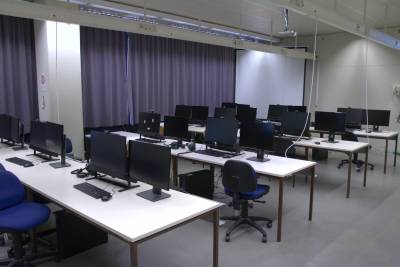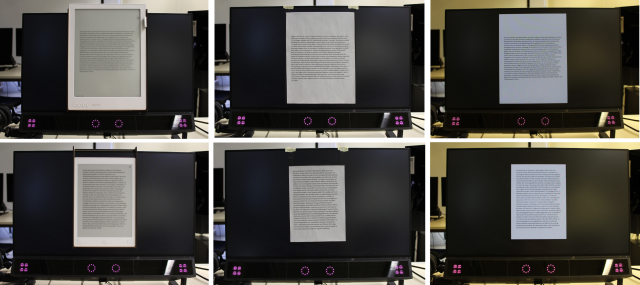Project: Reading on Different Media

We are investigating how different media affect reading performance and experience.
Status: ongoing
Runtime: 2020 -
Participants: Raphael Wimmer, Florian Bockes, Marie Sautmann, Michael Hebeisen
Keywords: reading, media, eye-tracking, e-paper
Background
Due to the advent and everyday use of digital devices, the question arises if and to what extend these devices influence reading. For many applications the use of different media is conceivable and possible. Reading can be done on a smartphone, tablet, laptop or eReader as well as in a newspaper or book. The question arises whether and how these different media affect reading behavior and whether they are all equally suitable for reading.
Although current meta-analyses cannot unequivocally answer the question of differences in reading speed and text comprehension when reading on different media (Delgado et al., 2018), reading on paper seems to have advantages over reading on digital media (Clinton, 2019; Delgado et al., 2018). However, the effect of the medium has been rather neglected in previous works (Delgado et al., 2018; Singer & Alexander, 2017).
Goals
We aim to develop a study design, making an effort to measure only the effect of the medium itself for comparison. Therefore controlling as many confounding factors as possible is a major focus.
Status
In order to determine more precisely which properties of the media support or hinder reading, a study design was developed within the framework of two final theses:
- Hebeisen, M. (2020). Einflüsse verschiedener Textmedien auf das Leseverhalten
- Sautmann, M. (2020). Einfluss von Technologie und Größe verschiedener Anzeigemedien auf das Leseverhalten
Method and Results are described below.
Due to the COVID-19 pandemic, laboratory studies on reading behavior are difficult to implement at the moment and otherwise very costly.
As part of the research seminar media informatics (winter term 2020) a team focuses on this problem and aims to find ways to conduct remote reading studies under standardised conditions. Remote studies, in which the test participants read given texts at home, however, provide data that can be evaluated more difficult, since there are many more influencing factors that differ in each home. For more information on the project click here.
Future Work
Based on the developed study design, it is now possible to make specific changes and see whether these have an influence on reading behavior (e.g., different font sizes).
Method
The studies of Hebeisen and Sautmann examined the reading behaviour on eReader, paper and LCD screen. The three text media were each available in two different sizes (approximately DIN A5 and DIN A4). Reading speed, number of fixations and text comprehension were compared across the three text media. Data on those metrics was collected using an eye tracker and cloze texts.
All studies were conducted in the eye-tracking classroom of the Regensburg universities. The room offers eleven identical workstations, each equipped with a PC, two monitors, eye tracker (and associated software), integrated speaker, headphones, mouse and keyboard.
Hebeisen conducted two main studies after some preliminary studies: the first with a smaller eReader (reMarkable) and the second with a larger eReader (Onyx Boox Max 2 Pro). In both studies, the subjects read three different german texts about the history of the railroad on one of the text media each. In his studies he controlled the study environment (brightness, noise, temperature), interaction and haptics, as well as position, size, contrast and display brightness of the text media.
Sautmann aimed to reproduce the study of Hebeisen. Some details in the study design were improved - for example, the reading texts were evaluated using quantitative readability metrics and a preliminary study. Furthermore, the method for contrast adjustment was improved. In Sautmann's study, the subjects read six different german texts about the history of the railroad on one of the text media each.
Results
Hebeisen conducted both main studies with 36 subjects (main study “10.3 inch”: 22 male, 14 female, average age 23.1 years | main study “13.3 inch”: 20 male, 16 female, average age 23.2 years). The results were examined for statistical significance using ANOVA Repeated Measures.
For the main study “10.3 inch” no statistically significant difference in reading speed between the different text media could be found. Statistically significant differences were found for the fixation number and text comprehension. For the main study “13.3 inch” statistically significant differences were found for reading speed, fixation number and text comprehension.
Sautmann conducted her main study with 19 subjects (11 male, 8 female, average age 23.8 years.) She could not reproduce Hebeisen's results. No clear differences in the effect of the text media or an influence of the size of the text medium could be detected.
Resources
Clinton, V. (2019). Reading from paper compared to screens: A systematic review and meta‐analysis. Journal ofResearch in Reading, 42 (2), 288–325. doi: 10.1111/1467-9817.12269 (retrieved here on 20-11-2020)
Delgado, P., Vargas, C., Ackerman, R. & Salmerón, L. (2018). Don’t throw away your printed books: A meta-analysis on the effects of reading media on reading comprehension. Educational Research Review, 25, 23–38. doi: 10.1016/j.edurev.2018.09.003 (retrieved here on 20-11-2020)
Hebeisen, M. (2020). Einflüsse verschiedener Textmedien auf das Leseverhalten [Unpublished master thesis]. Universität Regensburg.
Sautmann, M. (2020). Einfluss von Technologie und Größe verschiedener Anzeigemedien auf das Leseverhalten [Unpublished bachelor thesis]. Universität Regensburg.
Singer, L. M.& Alexander, P. A. (2017, Januar). Reading Across Mediums: Effects of Reading Digital and Print Texts on Comprehension and Calibration. The Journal of Experimental Education, 85 (1), 155–172. doi: 10.1080/00220973.2016.114379 (retrieved here on 20-11-2020)




